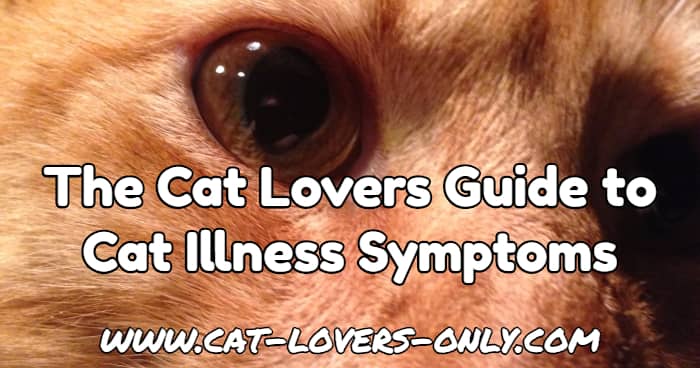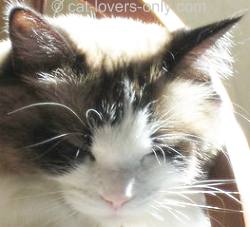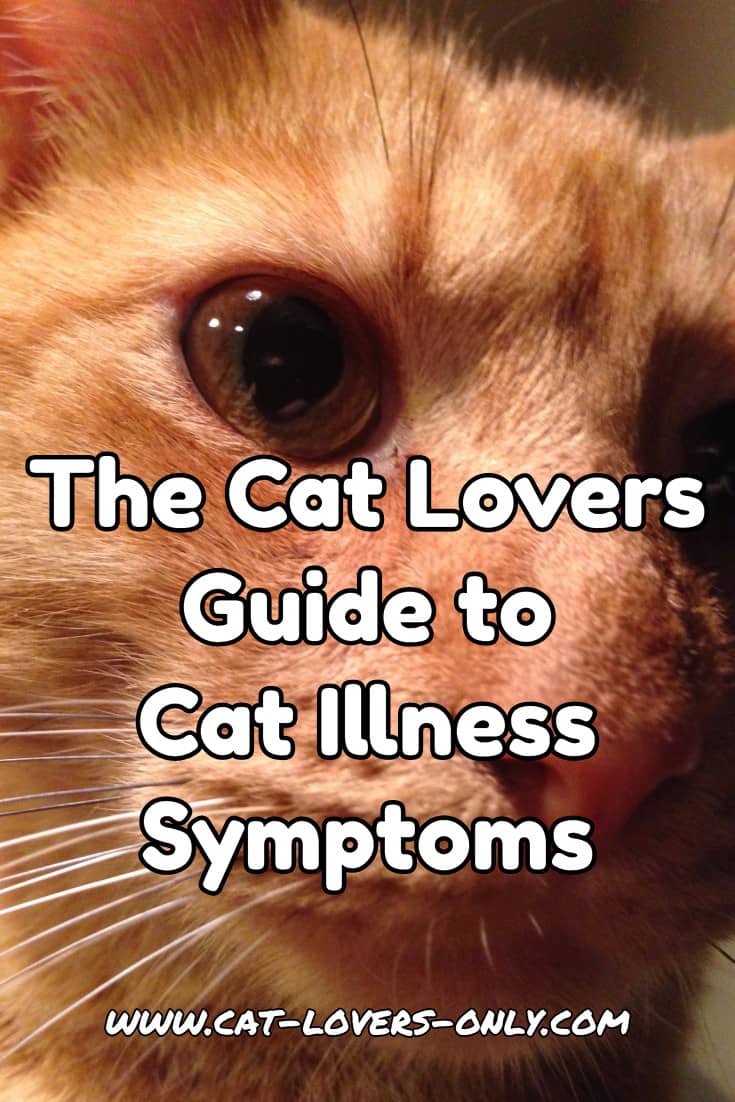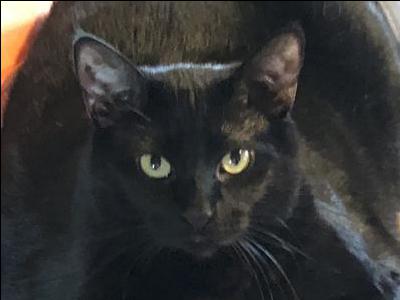Cat Illness Symptoms Guide
Which cat illness symptoms match which disease or condition?
That's really a question only your veterinarian can answer, but let's look at some issues you may face with your kitty.
The thing is, cats are really good at hiding pain, discomfort and other signs of illness.
That means that by the time you notice something's wrong, it's usually time to call the veterinarian.

Whether you're waiting for your vet appointment, or just gotten back from a vet visit, however, this information is here to help give you some additional perspective.
When you notice cat illness symptoms, it can be very stressful for you and your cat. Sometimes it's even hard to tell if your cat is sick or not.
Your cat can't tell you if she has an illness, or what her symptoms are.
She can't tell you that she feels sick, where it hurts... or even if it hurts.
In addition, many symptoms are common to more than one ailment, and some diseases can be difficult to diagnose.
That can be both scary and frustrating for you, and put you in an "I don't know what to do" state.
If you suspect your cat has a medical problem, knowing what symptoms to look for may be helpful. Use this cat illness symptoms guide to help you better care for your cat, work with your veterinarian, and ease your mind.

House cats have been referred to as having "one foot in the wild." Wild animals, as a survival method, have to hide signs of disease or weakness.
Domestic cats are also very good at this, which means that you have to be that much more observant of your feline friend's behavior at all times.
A few words of advice follow about how to use the cat illness symptoms guide. If you'd like to just skip all that and jump directly to the symptoms list, feel free, just make sure that you follow my cautionary advice.
The Cat Illness Symptoms Guide
Table of Contents
How To Use This Cat Illness Symptoms Guide
Before we just dive into a cat illness symptoms list, a quick word on how to use this guide is in order. I have created this guide for you to use as a "work in progress supplement" to regular cat health care provided by your veterinarian.
It is not intended to replace regular veterinary care, nor is it intended to be used to diagnose, or recommend treatment for, any illness. It is strictly here to provide information.
In addition, vet visits are only one piece to the cat care puzzle. You, as the primary care giver have to be alert to any sign of illness in your cat, and act accordingly.
It just may be your keen observation of a behavior change in your cat that uncovers a feline illness that needs medical treatment, rather than something that your vet notices in a once a year exam.
Cautionary Advice
First off, looking at a list of cat illness symptoms is not going to turn you into a cat health expert. I am not a cat health expert, nor a veterinarian, nor a pet psychologist.
Do not try to diagnose or treat your cat yourself. Contact your veterinarian if you suspect that your cat has an illness.
Second, this list is by no means comprehensive... there will always be cat diseases and symptoms that I haven't researched or published.
Third, many symptoms on the cat illness symptoms list, by themselves, may mean nothing. Others can be signs of an obvious problem. For example, if your cat vomits 12 times in two hours, it would be logical for you to conclude that a vet visit is in order. Whether something major is wrong or not, it's obvious that there is some sort of problem that your vet needs to look at right away.
But, if your cat vomits one time, it may mean nothing. Maybe she just had a fur ball, or ate some grass. On the other hand, it is sometimes easy to overlook that your cat has been exhibiting several other behavior patterns that may indicate a cat health alert.
When you add it up, maybe throwing up is just an indication that the problem is getting worse. Or, maybe she threw up more than once and you just haven't seen the evidence yet!
You can't be too careful. Observation is the key.
Fourth, a well adjusted cat is a healthier cat. The core of any cat health care regimen starts with providing an inviting, clean, safe, cat friendly environment for your kitty.
Cats need to be able to explore their territory in a cat safe environment, get good rest, good nutrition from premium cat food, and exercise. A well fed, well rested, well protected cat is more likely to remain healthy longer.
OK, enough of my ramblings, on to the guide to feline illness symptoms, starting with...
Major Cat Medical Problems
Infectious Diseases
Feline infectious peritonitis (FIP)
Feline infectious peritonitis (FIP) is the most feared disease in catteries, as it is the leading infectious cause of cat death. FIP is caused by a coronavirus infection (FCoV).
As it presents symptoms that are common to many other ailments and conditions, and tests are not always accurate, it is difficult to diagnose.
In addition, symptoms can be very individualized, as there are two types of the disease, and different areas of the body may be affected in each cat.
Feline Immunodeficiency Virus (FIV)
Feline Immunodeficiency Virus (FIV) belongs to the same family of viruses as HIV (human immunodeficiency virus). This family of viruses, known as Lentiviruses (or "slow virus") is species-specific.
As the names imply, FIV is specific to cats, HIV is specific to people. They are known for life-long infection, and slowly progressive diseases.
Feline Leukemia Virus (FeLV)
Feline Leukemia Virus (FeLV) is a feline retrovirus that causes both fatal cancerous and non-cancerous diseases. It is easily destroyed by household detergents and bleach, warmth and drying, and does not survive long outside the cat. It is carried in saliva and tears, and perhaps the urine and feces of infected cats.
Due to the fact that it does not survive in the environment, it is contagious only by direct, prolonged, intimate wet contact with an infected cat that is shedding the virus. There is no evidence that FeLV is transmissible to humans or any other animal species other than members of the cat family.
Feline Leukemia Virus Symptoms
Cat Ringworm
Ringworm (dermatophytosis) is the most common infectious skin disease in domestic felines. It is not actually a worm at all, but a fungal infection spread through spores. If infected, your cat may or may not be bothered by ringworm symptoms as some cases are asymptomatic.
Ringworm is a self limiting disease, meaning that it can clear up by itself, but this may take months. It can be hard to cure, and the spores can be difficult to remove from a home, kennel, or shelter.
Medical Disorders
Feline Diabetes
Feline diabetes (diabetes mellitus), known as "sugar" diabetes, is a common disorder of the endocrine system in the cat. It often affects older, obese males, but can afflict any cat. As far as cat illness symptoms go, diabetes can be varied, since it presents differently in each cat, and it can lead to other conditions.
Feline diabetes symptoms will vary depending upon the type and stage of the disease. Excessive urination (polyuria), and excessive thirst (polydipsia) are the classic signs of diabetes in cats.
Although the exact cause in cats is not known, diabetes has been linked to pancreatic disease, hormonal imbalances, and certain medications. Obesity is a factor, so if your cat is overweight, be alert to feline diabetes symptoms. Unfortunately, genetic predisposition is also implicated.
Regardless of food intake levels, diabetic cats lose weight because the cells are unable to process glucose normally. As the disease progresses, it can lead to further metabolic disturbances and causes vomiting, loss of appetite, weakness, and dehydration. With treatment, a diabetic cat can live many good years, and some even lose their need for treatment over time.
Feline Lower Urinary Tract Disease (FLUTD)
Feline lower urinary tract disease, or FLUTD, is a collection of clinical symptoms and signs that have varying causes. These symptoms can sometimes be confused with other conditions, and vary from patient to patient.
Diseases of the lower urinary tract occur frequently in cats, and more often in males than females. They affect the bladder and/or the urethra (the tube that the urine flows through from the bladder on its way out of the body).
In male cats, this condition can become an obstructed urinary tract, which is a life threatening disease. FLUTD used to be known as feline urologic syndrome, or FUS. The name was changed to encourage better diagnosis of the root causes of the symptoms, leading to better treatment.
Gastrointestinal Parasites in Cats
There are a number of cat parasites that fall into the gastrointestinal category. These feline parasites are basically of two types: worms in cats (such as roundworms, hookworms, tape worms, or stomach worms) or single-celled (as in Isospora, Giardia, or Toxoplasma gondii) organisms.
Cat stomach and intestinal parasites can produce signs and symptoms that are many and varied. According to the Cornell Feline Health Center, the signs are "fairly nonspecific" and some of the cat illness symptoms "caused by intestinal parasites will weaken a cat, making it more susceptible to viral and bacterial infections and diseases."
Since most cat parasite infections are passed from cat to cat, the chances of infection are greater in places with large cat populations and overcrowding, such as shelters. Prevalence rates can be as high as 45 percent.
This can be significant not only for the cat population, as some parasites have the potential to infect humans as well (zoonotic disease). One such common zoonotic disease is toxoplasmosis (signs and symptoms of toxoplasmosis).
Feline Inflammatory Bowel Disease (Feline IBD)
Feline Inflammatory Bowel Disease (Feline IBD) is not a specific disease. It is a group of chronic gastrointestinal disorders. High on the list of symptoms for IBD are chronic vomiting and diarrhea.
In most cases Feline IBD can be controlled by medication and dietary management, but the disease is rarely cured (more on treating diarrhea in cats).
Age Related Disorders
As they age, cats, like humans, can develop signs and symptoms of age related disorders. And, like humans, cats are living longer. A number of physical and behavioral changes occur during the aging process.
Many conditions that affect aging cats, while not correctable, can be controlled through diet, medications, or environmental changes.
Looking at the cat illness symptoms list with respect to senior cat health, aging cats can exhibit signs of any number of diseases that may or may not be related specifically to aging.
For example, as a cat ages, the immune system weakens, making the possibility of infections more common. We wouldn't necessarily associate an infection directly with aging, but perhaps an age-related weakened immune system could be to blame.
Some vets believe that making healthier cat food choices may help your cat to remain healthy longer. This is especially true if your cat suffers from or is at risk for any of these common elderly cat health problems.
In addition, some cat health experts recommend supplements, to boost the immune system of your cat.
Dehydration, skin conditions, overgrown and brittle claws, hearing loss, bad breath associated with dental disease, clouded eyes, inactivity, excessive meowing or howling, and an unusual demand for more attention can all be cat illness symptoms due to age related conditions.
In addition, impaired kidney function, loss of appetite, hyperthyroidism, high blood pressure, feline diabetes, and bowel conditions such as feline inflammatory bowel disease (IBD) are more common in older cats. There is also an increased risk of cancer as cats get older.
Work closely with your veterinarian to understand which, if any, senior cat health problems your cat has or might experience in the future. Knowing which ailments your cat is most prone to will help you to identify signs and symptoms early.
You can then work with your veterinarian to alter your pet's diet, your routine at home, or your cat's environment so that she can be as happy and healthy as possible.
Further Reading
Information on Feline Illnesses, Diseases, and Care (AVMA)
Cat Health Articles (Winn Feline Foundation)
Buy Pet Medication Online and Save Money
 If you think this Cat Illness Symptoms Guide will help other cat lovers, click "Save" to share this information on Pinterest.
If you think this Cat Illness Symptoms Guide will help other cat lovers, click "Save" to share this information on Pinterest.
Comments: What do you think?
Have your say about what you just read. Leave me a comment in the box below.